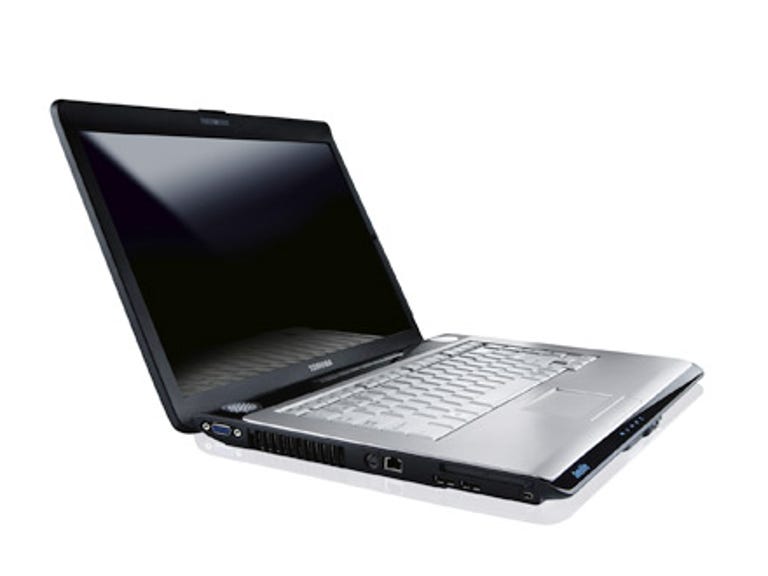 Why You Can Trust CNET
Why You Can Trust CNET Toshiba Satellite A200 (Pentium 1.86Ghz, 1GB RAM) review: Toshiba Satellite A200 (Pentium 1.86Ghz, 1GB RAM)
The Satellite A200 is a decent machine for basic productivity needs, but otherwise does little to mark it out from the budget laptop pack.
Design
Notebook companies love a consistent design; not only does it save a ton of money on manufacturing costs, but it also allows them to create a definitive brand identity. Placing the A200 next to its more diminutive (and more costly) sibling, the M200, and it's hard not to think of them as brothers -- the basic design of both notebooks is essentially identical at first glance.
The Good
The Bad
The Bottom Line
That first glance can be a touch deceptive, however. The A200 -- or to give the review version submitted to CNET.com.au its full name, the PSAF0A-0YK01C -- is a cheaper unit, although with an asking price of AU$1,199 (sans the current at time of writing AU$100 cashback), it's not that much cheaper. What that does translate into is a more business feel to the A200's style; gone is the shiny fingerprint prone piano black of the M200 in favour of a matte surface. The A200 is also a substantially larger notebook, thanks to its 15.4-inch LCD screen. This gives it measurements of 362 x 267.8 x 33.5mm, with a carrying weight of 2.72kg. Or, in other words, this is a near desktop replacement machine, or portable for people with really strong arms.
Features
The A200 submitted to CNET is the entry level machine that Toshiba offers locally, and it shows when you examine the basic specifications, especially against the not that much more costly M200. The processor that runs the A200 is an Intel Pentium Processor T2130 running at 1.86Ghz, with 1GB of onboard memory, upgradeable to 4GB. Graphics are provided by the integrated Intel Graphics Media Accelerator 943GML, which will by default take 64MB of memory for its rendering tasks, up to a maximum of 256MB. Interestingly, Toshiba's opted not to go for the full Centrino package with the A200, as it omits Intel's wireless solution in favour of an Atheros 802.11b/g chip. Connectivity comes in the form of four USB 2.0 ports, 10/100 Ethernet, V.92 modem, memory card reader and a firewire port. Like the M200, the A200 comes with an integrated 1.3 megapixel web camera. The system ships with Windows Vista Home Premium edition.
Performance
Remember how we mentioned the benefits of a standardised design earlier? Well, in the A200's favour, that standard design means that all of the physical attributes we liked about the M200 are present in the A200. The keyboard has excellent response and tactile feel, and the larger physical size of the A200 means it's more comfortable for those with larger hands. Like the M200, it uses a scroll wheel for volume, which is exceptionally handy, and the 15.4-inch display screen is an even better display vehicle for presentations and multimedia applications -- as long as your needs are relatively simple.
In our benchmark tests, the relative weakness of the A200's graphics and processor capabilities stood out in the manner of pained digits everywhere. Its PCMark05 score of 2881 would be fine in a productivity setting, but not if you're going to heft around large files or expect things to resolve particularly quickly. On an even less stellar note -- and with no great surprise -- the A200 fared badly in 3DMark06, managing a score of only 151. Unless you like minesweeper a whole lot, this couldn't be described as a gamer's machine.
Where the A200 did surprise us in the benchmark stakes was in battery life. We ran our standard DVD battery test over the A200, which involves playing a DVD on the laptop with all battery saving features disabled and the screen set to maximum brightness. Conventional wisdom would suggest that the larger screen on the A200 would see it fall well before the M200, but the reverse was true, as the A200 powered on for nearly twenty minutes more than the M200, finally giving up after one hour and fifty five minutes of DVD playback. Bear in mind that for basic productivity work, you're likely to get more out of the battery than we do just churning the drive and screen with a DVD.
As a basic productivity machine, the A200 fares well, but this sector of the notebook market is absolutely feral at the time of writing, and you'd be well advised to check around other vendors with similar specification machines, as plenty of those are starting to crop up around the AU$1,000 mark, and even below that.


